Proportional Reasoning-1 NCERT Solutions | Mathematics Class 8- New NCERT (Ganita Prakash) PDF Download
| Table of contents |

|
| Page 165 |

|
| Page 166 |

|
| Page 167 |

|
| Page 170-171 |

|
| Page 175 |

|
| Page 176-177 |

|
Page 165
Figure it Out
Q1. Circle the following statements of proportion that are true.
(i) 4 : 7 :: 12 : 21
(ii) 8 : 3 :: 24 : 6
(iii) 7 : 12 :: 12 : 7
(iv) 21 : 6 :: 35 : 10
(v) 12 : 18 :: 28 : 12
(vi) 24 : 8 :: 9 : 3
Ans:
(i) 4 : 7 :: 12 : 21
4 : 7 → Already in its simplest form.
12 : 21 → H.C.F = 3 → 12/3 : 21/3 = 4 :7.
Both ratios are equal, so the proportion is true.
(ii) 8 : 3 :: 24 : 6
8 : 3 → Already in its simplest form.
24 : 6 → H.C.F = 6 → 24/6 : 6/6 = 4 : 1.
Since both ratios are not equal, so the proportion is true.
(iii) 7 : 12 :: 12 : 7
7 : 12 → Already in its simplest form.
12 : 7 → Already in its simplest form.
Since both ratios are not equal, so the proportion is true.
(iv) 21 : 6 :: 35 : 10
21 : 6 → H.C.F = 3 → 21/3 : 6/3 = 7 : 2.
35 : 10 → H.C.F = 5 → 35/5 : 10/5 = 7 : 2.
Since both ratios are equal, so the proportion is true.
(v) 12 : 18 :: 28 : 12
12 : 18 → H.C.F = 6 → 12/6 : 18/6 = 2 : 3.
28 : 12 → H.C.F = 4 → 28/4 : 12/4 = 7 : 3.
Since both ratios are not equal, so the proportion is false.
(vi) 24 : 8 :: 9 : 3
24 : 8 → H.C.F = 8 → 24/8 : 8/8 = 3 : 1.
9 : 3 → H.C.F = 3 → 9/3 : 3/3 = 3 : 1.
Since both ratios are equal, so the proportion is true.
Q2. Give 3 ratios that are proportional to 4 : 9.
______ : ______ ______ : ______ ______ : ______
Ans: To find ratios proportional to 4 : 9, we multiply both terms by the same number:
4 × 2 : 9 × 2 = 8 : 18.
4 × 3 : 9 × 3 = 12 : 27.
4 × 5 : 9 × 5 = 20 : 45.
So, three ratios proportional to 4 : 9 are 8 : 18; 12 : 27; and 20 : 45.
Q3. Fill in the missing numbers for these ratios that are proportional to 18 : 24.
3 : ______, 12 : ______, 20 : ______, 27 : ______
Ans: Simplifying 18 : 24
H.C.F = 6 → 18/6 : 24/6 = 3 : 4.
So any proportional ratio must equal 3 : 4.
(i) 3 : ______ = 3 : 4
(ii) 12 : ______ = 3 × 4 : 4 × 4 = 12 : 16.
(iii) 20 : ______ = 3 × 20/3 : 4 × 20/3 = 20 : 80/3.
(iv) 27 : ______ = 3 × 9 : 4 × 9 = 27 : 36.
Page 166
Q4. Look at the following rectangles. Which rectangles are similar to each other? You can verify this by measuring the width and height using a scale and comparing their ratios.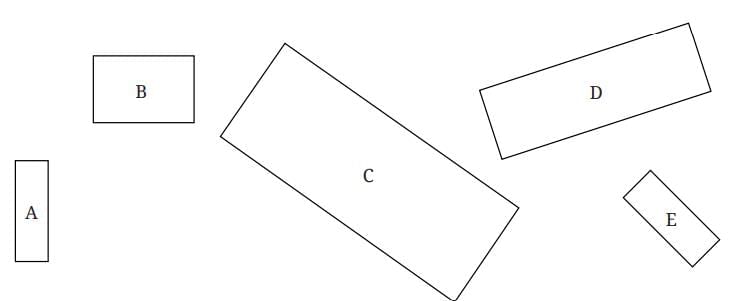 Ans: Rectangles C, D, and E look similar.
Ans: Rectangles C, D, and E look similar.
Let the Length and Width of rectangle C be 3 and 9, respectively.
Let the Length and Width of rectangle D be 2 and 6, respectively.
Let the Length and Width of rectangle E be 1 and 3, respectively.
As we can see, all three ratios are equal and in the same proportion, 1 : 3.
Q5. Look at the following rectangle. Can you draw a smaller rectangle and a bigger rectangle with the same width to height ratio in your notebooks? Compare your rectangles with your classmates’ drawings. Are all of them the same? If they are different from yours, can you think why? Are they wrong?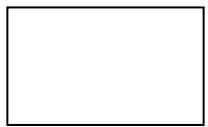 Ans: Smaller Rectangle:
Ans: Smaller Rectangle:
Bigger Rectangle: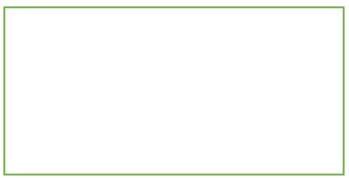
Q6. The following figure shows a small portion of a long brick wall with patterns made using coloured bricks. Each wall continues this pattern throughout the wall. What is the ratio of grey bricks to coloured bricks? Try to give the ratios in their simplest form.
Ans:
(a) Total bricks = 51
Red coloured bricks = 18
So, Grey coloured bricks = 51 - 18 = 33
∴ Required ratio = 33 : 18 = 11 : 6
(b) Total bricks = 119
Yellow coloured bricks = 48
So, Grey coloured bricks = 119 - 48 = 71
∴ Required ratio = 71 : 48
Page 167
Q7. Let us draw some human figures. Measure your friend’s body—the lengths of their head, torso, arms, and legs. Write the ratios as mentioned below—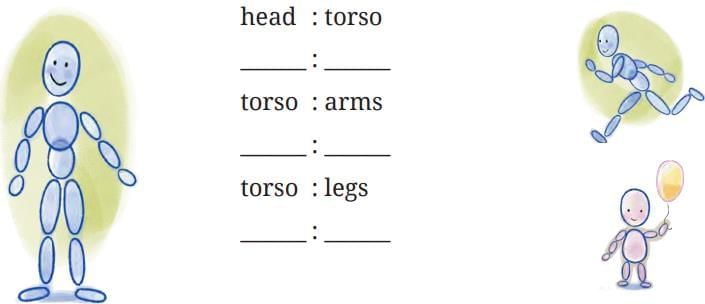
Now, draw a figure with head, torso, arms, and legs with equivalent ratios as above.
Ans: My friend’s body measurements:
(i) Head = 22 cm
(ii) Torso (neck to hip) = 50 cm
(iii) Arms (shoulder to fingertip) = 60 cm
(iv) Legs (hip to foot) = 80 cm
1. Head : Torso = 22 : 50
Simplify by dividing both by 2 → 11 : 25.
2. Torso : Arms = 50 : 60
Simplify by dividing both by 10 → 5 : 6.
3. Torso : Legs = 50 : 80
Simplify by dividing both by 10 → 5 : 8.
So the ratios are:
- Head : Torso = 11 : 25
- Torso : Arms = 5 : 6
- Torso : Legs = 5 : 8
Page 170-171
Q1. The Earth travels approximately 940 million kilometres around the Sun in a year. How many kilometres will it travel in a week?
Ans: Let be the earth travel x million km in a week
If the Earth moves at the same speed, then the ratio of distance is proportional to time.
∴ 1 year : 1 week :: 940 million km : x million km
52 : 1 :: 940 : x [1 year = 52 weeks]
Therefore, 52/1 = 940/x
Or, 52x = 940
Or, x = 940/52 or, x = 18.07
Hence, 18.07 kilometres will it travel in a week.
Q2. A mason is building a house in the shape shown in the diagram. He needs to construct both the outer walls and the inner wall that separates two rooms. To build a wall of 10-feet, he requires approximately 1450 bricks. How many bricks would he need to build the house? Assume all walls are of the same height and thickness.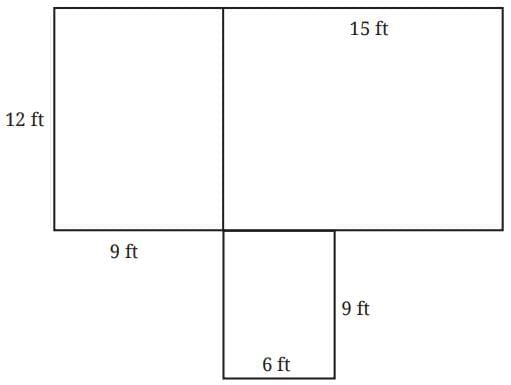 Ans:
Ans: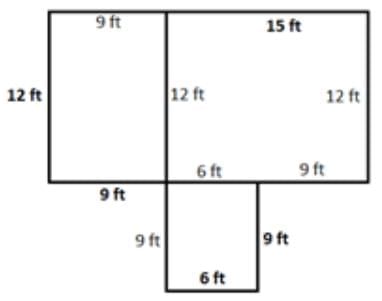 Perimeter of the house = (9 + 15 + 12 + 9 + 9 + 6 + 9 + 9 + 12) = 90 ft
Perimeter of the house = (9 + 15 + 12 + 9 + 9 + 6 + 9 + 9 + 12) = 90 ft
Length of inner wall = (12 + 6) ft = 18 ft
∴ Total length of wall required to build = (90 + 2 × 18) ft = 126 ft
To build a wall of 10-feet, he requires approximately 1450 bricks.
Let be the total number of bricks required = x
Therefore, 10 : 126 :: 1450 : x
Or, 10/126 = 1450/x
Or, x = 145×126
Or, x = 18270
Hence, 18270 bricks would he need to build the house.
Page 175
Q1. Divide ₹4,500 into two parts in the ratio 2 : 3.
Ans: Total number of part = (2 + 3) = 5
∴ First part has = Rs. 2/5 × 4500 = Rs. 1800
So, the second part has = Rs. 3/5 × 4500 = Rs. 2700
Q2. In a science lab, acid and water are mixed in the ratio of 1 : 5 to make a solution. In a bottle that has 240 mL of the solution, how much acid and water does the solution contain?
Ans: Ratio of mixed solution of acid and water is = 1 : 5
Total part is = 1 + 5 = 6
∴ Amount of acid contain = 1/6 × 240 mL = 40 mL
∴ Amount of water contain = 5/6 × 240 mL = 200 mL
Q3. Blue and yellow paints are mixed in the ratio of 3 : 5 to produce green paint. To produce 40 mL of green paint, how much of these two colours are needed? To make the paint a lighter shade of green, I added 20 mL of yellow to the mixture. What is the new ratio of blue and yellow in the paint?
Ans: Ratio of Blue and yellow paints in mixture = 3 : 5
To produce 40 mL of green paint, quantity of Blue pain needed = 3/(3 + 5) × 40 mL = 3/8 × 40 mL = 15 mL
∴ Quantity of yellow pain needed = 5/8 × 40 mL = 25mL
Now, add 20 mL of yellow to the mixture.
Then, the ratio of blue and yellow in the new mixture =15 : (25 + 20) = 15 : 45 = 1 : 3
Q4. To make soft idlis, you need to mix rice and urad dal in the ratio of 2 : 1. If you need 6 cups of this mixture to make idlis tomorrow morning, how many cups of rice and urad dal will you need?
Ans: Required ratio of rice and urad = 2 : 1 and total quantity of mixture = 6 cups
∴ Amount of rice required = 2/(2 + 1) × 6 = 2/3 × 6 = 4 cups
∴ Amount of urad required = 1/(2 + 1) × 6 = 1/3 × 6 = 2 cups
Q5. I have one bucket of orange paint that I made by mixing red and yellow paints in the ratio of 3 : 5. I added another bucket of yellow paint to this mixture. What is the ratio of red paint to yellow paint in the new mixture?
Ans: I have one bucket of orange paint that I made by mixing red and yellow paints in the ratio of 3 : 5.
So, total parts = 3 + 5 = 8 parts
New quantity of red paint = 3 parts [Unchanged]
New quantity of yellow paint = 5 + 1 = 6 parts
∴ New ratio of red paint to yellow paint in the new mixture = 3 : 6 = 1 : 2
Page 176-177
Q1. Anagh mixes 600 mL of orange juice with 900 mL of apple juice to make a fruit drink. Write the ratio of orange juice to apple juice in its simplest form.
Ans: Amount of orange juice = 600 mL and amount of apple juice = 900 mL
∴ The ratio of orange juice to apple juice in its simplest form = 600 : 900 = 2 : 3
Q2. Last year, we hired 3 buses for the school trip. We had a total of 162 students and teachers who went on that trip and all the buses were full. This year we have 204 students. How many buses will we need? Will all the buses be full?
Ans: Let be number of buses we need = x
The ratio of students and teachers is proportional to bus.
Therefore, 162 : 204 :: 3 : x
Or, 162/204 = 3/x
Or, 54x = 204
Or, x = 204/54 or, x = 3.77
So, number of bus we need this year is = 4.
No, not all buses will be full, the fourth one has (204-54×3) = 42 students and teachers.
Q3. The area of Delhi is 1,484 sq. km and the area of Mumbai is 550 sq. km. The population of Delhi is approximately 30 million and that of Mumbai is 20 million people. Which city is more crowded? Why do you say so?
Ans: The population of Delhi is = 30 million = 30000000 people and area of Delhi = 1,484 sq. km
∴ Population per sq. km in Delhi = 30000000/1484 = 20215. 63 ≈ 20215 people
The population of Mumbai is = 20 million = 20000000 people and area of Mumbai = 550 sq. km
∴ Population per sq. km in Mumbai = 20000000/550 = 36363. 63 ≈ 36363 people
Therefore, Mumbai city is more crowded than Delhi.
Because the population density of Mumbai is higher (about 36364 people) than that of Delhi (about 20215 people).
Q4. A crane of height 155 cm has its neck and the rest of its body in the ratio 4 : 6. For your height, if your neck and the rest of the body also had this ratio, how tall would your neck be?
Ans: Ratio of neck and the rest of body = 4 : 6
Height of the crane is = 155 cm
∴ Height of the neck = 4/(4 + 6) × 155 = 4/10 × 155 = 62 cm
Q5. Let us try an ancient problem from Lilavati. At that time weights were measured in a unit named palas and niskas was a unit of money. “If  palas of saffron costs 3/7 niskas, O expert businessman! tell me quickly what quantity of saffron can be bought for 9 niskas?”
palas of saffron costs 3/7 niskas, O expert businessman! tell me quickly what quantity of saffron can be bought for 9 niskas?”
Ans: Let be the quantity of saffron can be bought = x palas
Convert the given fraction into improper fraction
2 + 1/2= 5/2 palas and 3/7 niskas.
The ratio of palasis proportional to niskas.
Therefore, 3/7 : 9 :: 5/2 : x
Or, (3/7)/9 = (5/2)/x
Or, 3/7 × 1/9 = 5/2 × 1/x
Or, 3/63 = 5/2x
Or, 6x = 315
Or, x = 52.5
Hence, 52.5 palas of saffron can be bought for 9 niskas.
Q6. Harmain is a 1-year-old girl. Her elder brother is 5 years old. What will be Harmain’s age when the ratio of her age to her brother’s age is 1 : 2?
Ans: Present age of the old girl = 1 year and her brother’sage = 5 years
Let’s be, the girl’s age after x years = (1 + x) years and her brother’s age = (5 + x) years.
Therefore, (1 + x)/(5 + x) = 1/2
Or, 2 + 2x = 5 + x
Or, x = 3
After 3 years the ratio of her age to her brother’s age is 1: 2.
In that time the age of the girl is = (1 + 3) = 4 years
And the age of her brother = (5 + 3) = 8 years.
Q7. The mass of equal volumes of gold and water are in the ratio 37 : 2. If 1 litre of water is 1 kg in mass, what is the mass of 1 litre of gold?
Ans: The mass of equal volumes of gold and water are in the ratio = 37 : 2
Let be the mass of 1 litre of gold is = x kg
Therefore, 37 : 2 :: x : 1
Or, 37/2 = x
Or, 2x = 37
Or, x = 37/2 = 18.5
Hence, the mass of 1 litre of gold is 18.5 kg.
Q8. It is good farming practice to apply 10 tonnes of cow manure for 1 acre of land. A farmer is planning to grow tomatoes in a plot of size 200 ft by 500 ft. How much manure should he buy?
Ans: Apply 10 tonnes of cow manure for 1 acre = 43560 sq. ft of land
Area of plot = 200 ft × 500 ft = 100000 sq. ft
The ratio of plot is proportional to manure.
Let be the manure need = x tonnes
Therefore, 43560 : 100000 = 10 : x
Or, 43560/100000 = 10/x
Or, x = 100000/4356 or, x = 22.95
Hence, the farmer should buy = 22.95 tonnes manure.
Q9. A tap takes 15 seconds to fill a mug of water. The volume of the mug is 500 mL. How much time does the same tap take to fill a bucket of water if the bucket has a 10-litre capacity?
Ans: 10 litre = 10000 mL
A tap takes 15 seconds to fill 500 mL
Ratio of volumes = 10000 : 500 = 20 : 1
So, it fills 1 part in 15 seconds.
∴ The same tap will fill 10-litre capacity bucket in:
= 15 × 20 = 300 seconds = 5 minutes
Q10. One acre of land costs ₹15,00,000. What is the cost of 2,400 square feet of the same land?
Ans: We know, 1 acre = 43560 sq ft
One acre of land costs ₹15,00,000, i.e, 43560 sq ft of land costs ₹15,00,000
∴ 2,400 square feet of land costs 
Q11. A tractor can plough the same area of a field 4 times faster than a pair of oxen. A farmer wants to plough his 20-acre field. A pair of oxen takes 6 hours to plough an acre of land. How much time would it take if the farmer used a pair of oxen to plough the field? How much time would it take him if he decides to use a tractor instead?
Ans: Given: If a pair of oxen takes 4 hours to plough the same area of a field, then a tractor will take 1 hour, as A tractor can plough the same area of a field 4 times faster than a pair of oxen.
A pair of oxen takes 6 hours to plough an acre of land.
∴ For 20 acres, a pair of oxen will take = 6 × 20 = 120 hours
∴ A tractor will take = 120/4 = 30 hours
Q12. The ₹10 coin is an alloy of copper and nickel called ‘cupro-nickel’. Copper and nickel are mixed in a 3 : 1 ratio to get this alloy. The mass of the coin is 7.74 grams. If the cost of copper is ₹906 per kg and the cost of nickel is ₹1,341 per kg, what is the cost of these metals in a ₹10 coin?
Ans: Copper and nickel are mixed in a 3 : 1 ratio to get this alloy.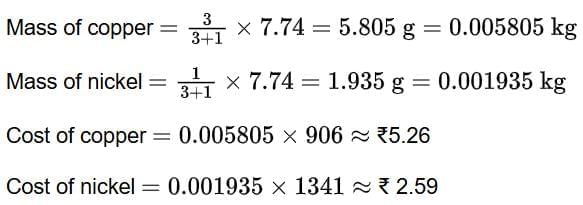
|
13 videos|110 docs|11 tests
|
FAQs on Proportional Reasoning-1 NCERT Solutions - Mathematics Class 8- New NCERT (Ganita Prakash)
| 1. What is proportional reasoning and how is it used in everyday life? |  |
| 2. How can I identify proportional relationships in a table of values? |  |
| 3. What are some common mistakes students make when solving proportional reasoning problems? |  |
| 4. Can you provide examples of real-world problems that involve proportional reasoning? |  |
| 5. What strategies can help improve my understanding of proportional reasoning? |  |















